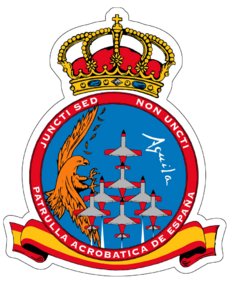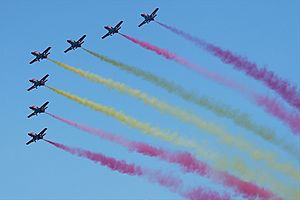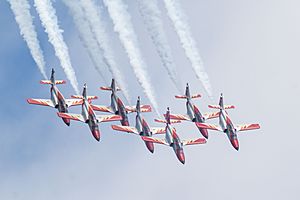Patrulla Águila facts for kids
Quick facts for kids Patrulla Águila |
|
|---|---|

Badge of the Patrulla Águila
|
|
| Active | 1985–present |
| Country | |
| Branch | Spanish Air and Space Force |
| Role | Aerobatic flight demonstration team |
| Garrison/HQ | San Javier Air Base |
| Colors | Red, yellow, white |
| Aircraft flown | |
| Fighter | 12 Casa C-101 Aviojet |
The Patrulla Águila (pronounced Pah-TROO-yah AH-gee-lah) means "Eagle Patrol" in Spanish. It is a special team of pilots from the Spanish Air and Space Force. They perform amazing air shows, flying their planes in cool formations.
This team was created on July 4, 1985. Their home base is the San Javier Air Base in Spain. This base is also where officers for the Spanish Air and Space Force are trained. The Patrulla Águila flies seven Casa C-101 Aviojet planes. They are famous for being the only team that uses yellow smoke during their shows. They are also well-known for their special way of landing their planes together in formation.
History of the Eagle Patrol

Before the Patrulla Águila was formed, other Spanish aerobatic teams performed. These teams flew different types of aircraft. They helped pave the way for the Eagle Patrol we know today.
Here are some of the teams that came before the Patrulla Águila:
- The Basic Air School of Matacán Patrol: This team started in 1954. They flew six T-6 Texan aircraft.
- The Jet Training Air School Patrol: Based at Talavera la Real Air Base, this team began in 1955. They used T-33 Shooting Star jets.
- The Ascua Patrol: This team started in 1956 at Manises Air Base in Valencia. They officially became the Patrulla Ascua in 1958. They flew F-86 Sabre planes.
- The Los Llanos Air Base Patrol: This team flew Mirage F-1 jets in 1980.
The Patrulla Águila had its very first training flight on June 4, 1985. The pilots chosen for the team were teachers from the Air Force Academy. They started flying the Casa C-101 Aviojet planes.
Meet the Team Members
The Patrulla Águila team has seven main pilots. They also have a team chief and other support staff. Each pilot has a special role in the formation.
| Pilot | Position |
|---|---|
| Miguel Puertas (Granada) | Chief of the team |
| Ignacio Sánchez-Heredero (Madrid) | Leader |
| César Piquer (Valencia) | Right Point |
| Antonio Monge (Madrid) | Left Point |
| Pedro M. Monleón (Valencia) | Dog |
| Antonio Gutiérrez (Granada) | Solo |
| Moisés Roca (Murcia) | Right pair |
| Mariano M. Navarro (Murcia) | Left pair |
| Alberto Bello (Cádiz) | Reserve |
Here are the roles of the pilots in the team:
- Leader (Eagle 1): This pilot flies at the front of the formation. The leader guides the entire team during their displays.
- Points (Eagles 2 and 3): These pilots fly behind the leader. One is on the right side, and the other is on the left.
- Dog (Eagle 4): The 'dog' pilot flies behind the leader and the points. Together, these four planes form a diamond shape.
- Solo (Eagle 5): This pilot performs special moves that show off the aircraft. They often fly alone for these exciting maneuvers.
- Pair (Eagles 6 and 7): These pilots fly on the sides of the main formation. They are responsible for tricks that need very precise flying and teamwork.
Interesting Facts
- In 2010, the Patrulla Águila celebrated its 25th anniversary. To mark this special occasion, one of their planes, Aviojet #5, was painted with a unique design.
- Aviojet #5 also has stickers that say "World Champion 2010." These stickers were originally made by the Netherlands Air Force. They planned to use them if their country won the football World Cup that year. However, Spain ended up winning the World Cup!
In January 2022, a C-101 plane from the Patrulla Águila was placed at the entrance of the Ciudad del Aire neighborhood. This neighborhood is in Alcalá de Henares, a town near Madrid. The plane was put there to honor Commander Eduardo Garvalena. He was a pilot who passed away on February 27, 2020, while serving his country. The plane has his name on its side and the number five on its tail.
See also
 In Spanish: Patrulla Águila para niños
In Spanish: Patrulla Águila para niños


